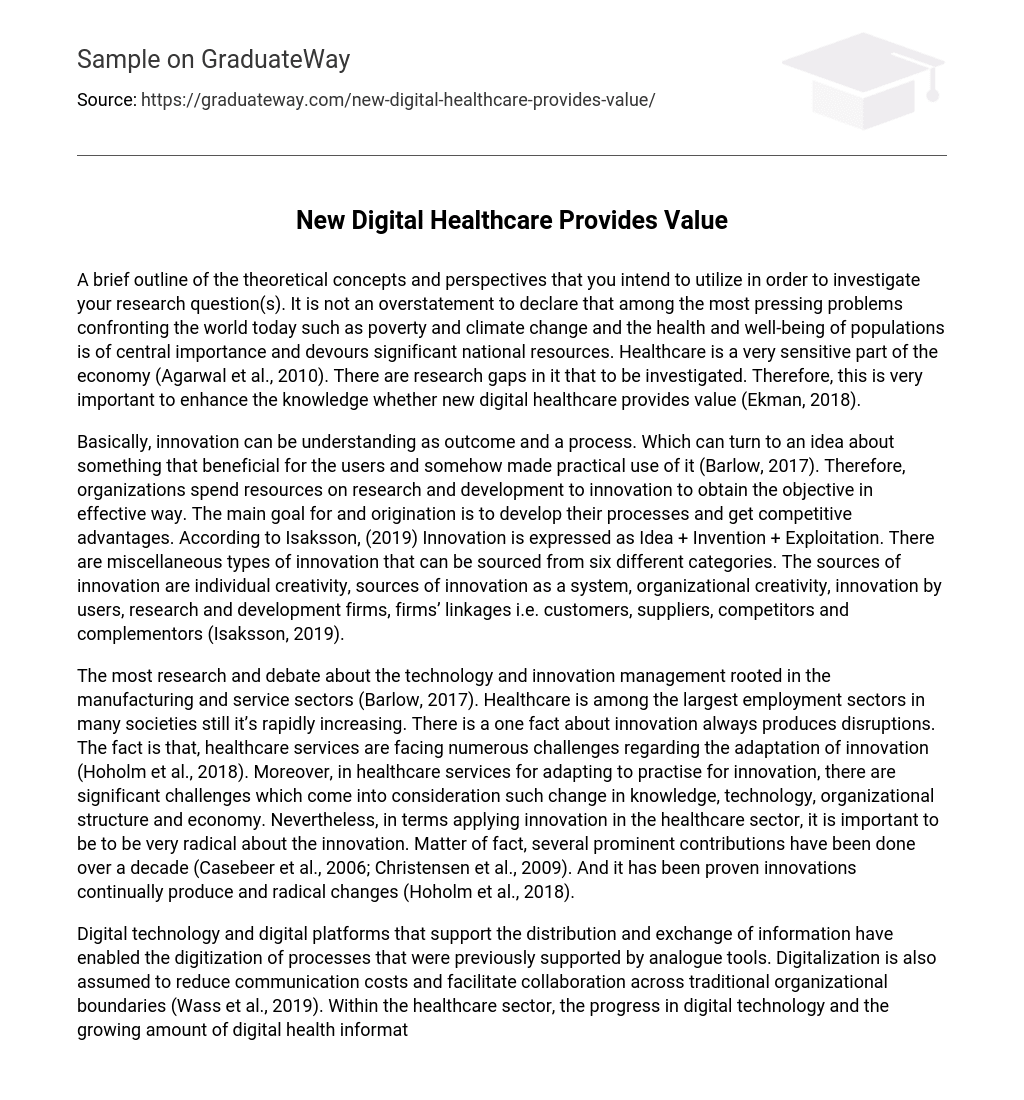A brief outline of the theoretical concepts and perspectives that you intend to utilize in order to investigate your research question(s). It is not an overstatement to declare that among the most pressing problems confronting the world today such as poverty and climate change and the health and well-being of populations is of central importance and devours significant national resources. Healthcare is a very sensitive part of the economy (Agarwal et al., 2010). There are research gaps in it that to be investigated. Therefore, this is very important to enhance the knowledge whether new digital healthcare provides value (Ekman, 2018).
Basically, innovation can be understanding as outcome and a process. Which can turn to an idea about something that beneficial for the users and somehow made practical use of it (Barlow, 2017). Therefore, organizations spend resources on research and development to innovation to obtain the objective in effective way. The main goal for and origination is to develop their processes and get competitive advantages. According to Isaksson, (2019) Innovation is expressed as Idea + Invention + Exploitation. There are miscellaneous types of innovation that can be sourced from six different categories. The sources of innovation are individual creativity, sources of innovation as a system, organizational creativity, innovation by users, research and development firms, firms’ linkages i.e. customers, suppliers, competitors and complementors (Isaksson, 2019).
The most research and debate about the technology and innovation management rooted in the manufacturing and service sectors (Barlow, 2017). Healthcare is among the largest employment sectors in many societies still it’s rapidly increasing. There is a one fact about innovation always produces disruptions. The fact is that, healthcare services are facing numerous challenges regarding the adaptation of innovation (Hoholm et al., 2018). Moreover, in healthcare services for adapting to practise for innovation, there are significant challenges which come into consideration such change in knowledge, technology, organizational structure and economy. Nevertheless, in terms applying innovation in the healthcare sector, it is important to be to be very radical about the innovation. Matter of fact, several prominent contributions have been done over a decade (Casebeer et al., 2006; Christensen et al., 2009). And it has been proven innovations continually produce and radical changes (Hoholm et al., 2018).
Digital technology and digital platforms that support the distribution and exchange of information have enabled the digitization of processes that were previously supported by analogue tools. Digitalization is also assumed to reduce communication costs and facilitate collaboration across traditional organizational boundaries (Wass et al., 2019). Within the healthcare sector, the progress in digital technology and the growing amount of digital health information have led to a change in the delivery of healthcare information within and across organizations and between patients and professionals (McGowan et al., 2012).
Health information technology’s literature is growing rapidly. Although, our review discloses that healthcare information technology research has largely focused on the impact on healthcare performance as well as issues related to the adoption of the HIT. Due to the digitalization and innovation, many studies have expressed the importance of healthcare information technology’s impact on various aspects of healthcare sector. It has become a basic part of healthcare (Agarwal et al., 2010). More simply, Healthcare Information Technology can transform the foundations and compatibility of health systems and contribute greatly to its long-term effectiveness and sustainability. Therefore, there has been tremendous growth in the number of online health information websites, portals, and databases (Singh and Lillrank, 2015).
In tradition way of storage medical data consist on the manual approach for recapitulating data limit the capacity of storage and analysis of hospital and clinic. To improve the data management and overcome the limitation of storage and analysis, several medical organizations have exercised significant effects to syndicates the large data resources and innovation technologies (Becker, 2017). presently, Electronic Healthcare Records (HERs) is using in big data analytics especially for important evaluation of diseases as well as performance of epidemiological analysis. For instant, it become breakthrough in healthcare information management (Hännikäinen, 2017; Perera et al., 2016).
Despites of it concept of big data systems successful, many healthcare institutes come across the early failure mostly adapting these new systems. In this era, there are many studies investigates the healthcare organizational barriers that stop healthcare services for implementing a successful big data system as well as finding the solution to these hindrances.
Even though, undoubtedly big data interduces many benefits to healthcare organizations. If sufficiently adapted and implemented in the healthcare services and the adaption entail internally in the organization. According to the studies big data management consider challengeable. Seth and Ram (1987) cited by Chena at al., (2020) describe barriers to adaption in the innovation are classified into five dimensions such as expertise, operation, resource regulation and access.
The foundation of big data consisting on texts, email, chat, review, news, image, audio video communications and search history. And it differentiates by the four dimensions such as, Volume, Velocity, Variety and Veracity (Guha and Kumar, 2017). Previously, the big data defined in terms of volume, velocity and variety. Later, the fourth dimension “veracity” was added, which increase to data accuracy and ultimately improves quality. These four dimensions make it possible to progress more sophisticated data analysis software.





